The best recipes for preparing dill for the winter, which is better for preservation, how to preserve the aroma
Dill has been a popular and widespread spice in many cultures for a long time. Today it can be found in the kitchen of almost every housewife. In addition to its specific taste, this herb is also famous for its medicinal properties, which are actively used in traditional and folk medicine. Greens are used in many dishes and housewives are trying to prepare dill for meals for the winter in such a way that it does not lose its useful properties.
Composition and useful properties
A spicy herb called dill is an annual. Its shoots and leaves add a fragrant aroma to every meal, from hot to snacks. The thing is that a special oil is present in the herb, which gives a pleasant smell to the plant.
In addition, the seasoning contains many vitamins:
- Ascorbic acid - helps to speed up the absorption of iron in the body; participates in the work of the immune system.
- Vitamin A - helps to strengthen the immune system, has a positive effect on the skin, organs of vision, and also enhances the ability to reproduce.
- Beta-carotene - imparts antioxidant properties to dill.
- Thiamin.
- Riboflavin.
- Pyridoxine.
- Pantothenic Acid.
- Alpha-tocopherol.
Many minerals are also present in dill:
- Calcium and Potassium.
- Magnesium.
- Phosphorus and iron.
- Sodium.
- Copper and manganese.
- Zinc.

All other useful components that make up the chemical composition of dill, as well as essential oil, induce appetite, increase the efficiency of the stomach and regulate metabolism. Spice, in general, has a positive effect on the functioning of the digestive system, can normalize blood pressure and reduce the risk of possible diseases of the cardiovascular system.
Patients suffering from kidney pathologies or cystitis during an exacerbation can use this herb for food - this will alleviate their condition.
In addition, moderate consumption of the seasoning will calm the nervous system, relieve unreasonable headaches and have a urinary and choleretic effect.
Attention! Experts recommend including dill in their diet for people who have pathologies of the kidneys, liver, gall bladder, gastritis and flatulence.When it comes to the nutritional value of the herb, leaners can take it easy. 100 grams of dill contains only 40 calories.
Preparing the necessary ingredients
Over the years, enterprising hostesses have come up with many ways to harvest dill for future use without destroying its beneficial properties.Before moving on to the recipes, you need to familiarize yourself with how to properly prepare a fragrant spice for storage.
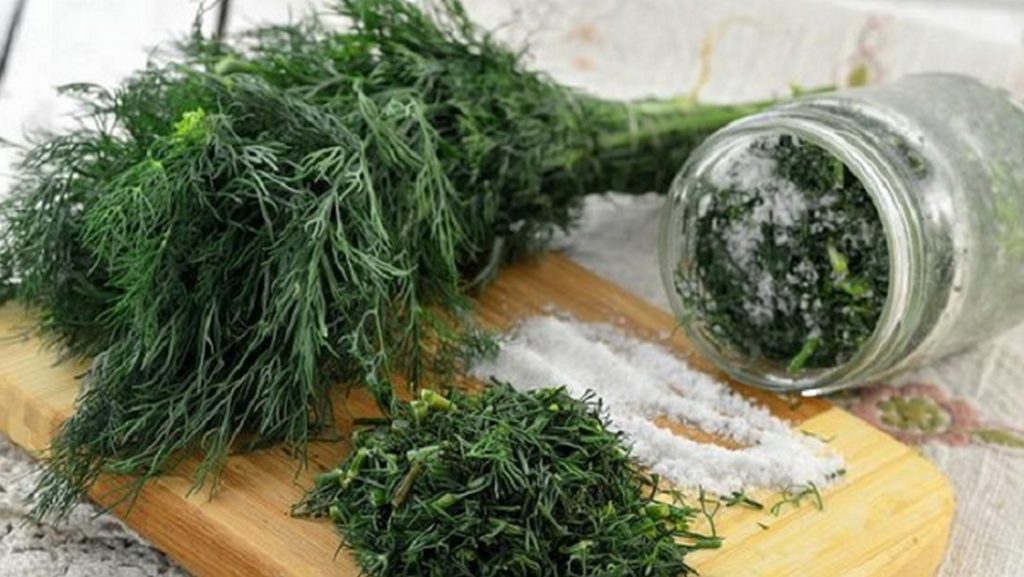
If you follow the recommendations, the herb will not deteriorate during the winter:
- Dill bought on the market or plucked in the garden must be washed. Hot water is not suitable for such a procedure; the best option would be slightly warm water at room temperature.
- Then the herb is dried by spreading it out on dry towels and leaving it for a while.
- When choosing a place to dry dill, it is required to take into account that direct sunlight should not fall on the plant.
- Also, the workpiece is protected by known methods from possible pests (flies, ants and others).
Methods for preparing dill for future use
Several techniques are known for storing fragrant spices during the winter. You can dry or freeze the dill, store it in oil, with salt, canning, or even pickle. Each woman chooses a recipe convenient for herself or tries several. All methods have their own subtleties and features, then more about them.

Drying
The difference between dried spicy herbs is that the plant harvested in this way has a strong aroma. It is best to add dried dill when preparing a hot first course.
There are several recipes for preparing greens by drying. The most popular ones are:
- Hang the washed bunch of fragrant spice on a rope for several days. The seasoning should be protected from direct UV rays, wind, and pests. A couple of days is enough, and the dill will be ready for the cold season.
- Chop the selected amount of the plant and spread it in a thin layer on a tray or paper. Stir the dill occasionally to dry it evenly, and it will be ready to winter in 3-4 days. Do not forget about the absence of sun, wind and insects in the place of preparation of greenery.
- Sometimes, in order to speed up the process of preparing the seasoning for the winter, housewives heat the spice using the oven. Given the high temperature regime, when dill is dried in this way, its leaves begin to curl up and acquire a yellowish tint. As a result, dried herbs don't look very pretty. This is the only drawback of this recipe for preparing the plant for winter.
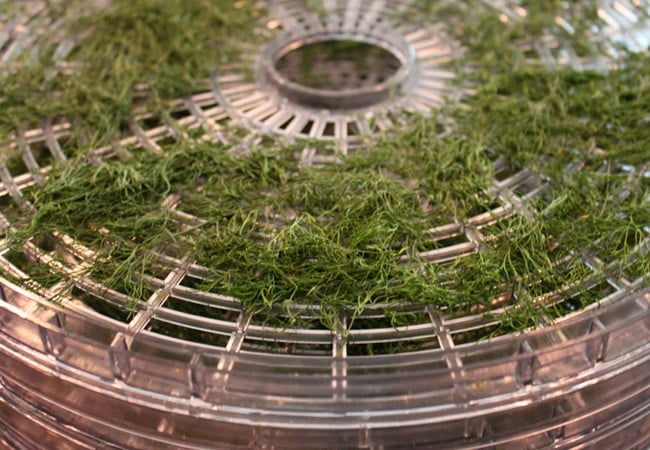
Freezing
This is one of the most popular ways of storing spices in winter among housewives. You can freeze greens chopped, in bunches or in ice cubes:
- Washed and dried fresh dill is crushed and evenly spread on the rack. It is recommended to stir the fragrant herb from time to time so that the leaves do not stick together. After 24 hours, the sprinkle is taken out of the refrigerator, the frozen herbs are poured into bags or plastic buckets.
- Those who do not want to do the chopping of a plant simply harvest bunches of grass and place them in a plastic bag or foil, and then send them to the freezer.
- Freezing dill with ice cubes is not a common technique, but it has been gaining popularity lately. To do this, add finely chopped spice to a freezer dish into cubes, pour water or butter.

Attention! The frozen seasoning can be stored in the refrigerator for six months without losing its beneficial properties and pleasant aroma.
Conservation
Preserving the fragrant spice during the cold winter months can be done by preserving. As you know, the canning process cannot take place without sterilization. Prepared jars must be sterilized and dried thoroughly, after which the washed greens are placed in jars and sealed with a lid. It is recommended to store such jars with dill in the cold. Fresh stems and leaves will retain all their vitamins and flavor for 1 to 2 months.
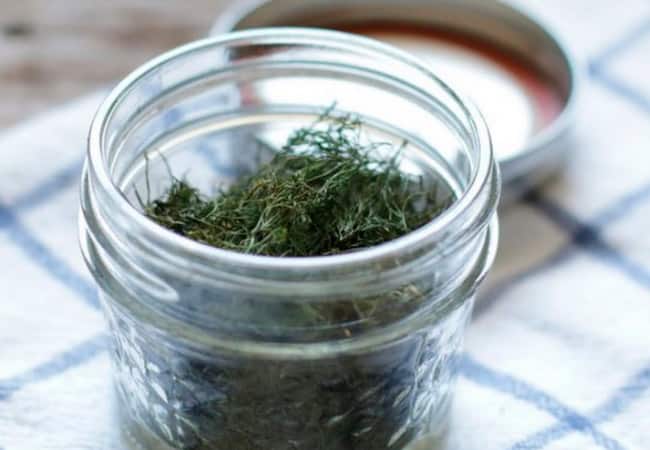
Pickled dill in jars for the winter
There are many varieties of herb marinade - this is another way to harvest aromatic herbs for future use. Here is one of the most delicious and popular recipes.
Ingredients:
- Dill - 350-500 grams.
- Citric acid - 25 grams.
- Garlic 3-4 snips.
- Bay leaf - 3 leaves.
- Sugar is a pinch.
- Salt - one teaspoon.
- Sunflower oil - glass.
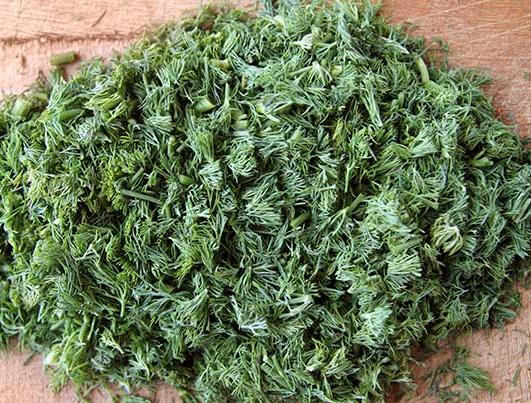
How to marinate the seasoning:
- Rinse and dry the herbs.
- Peel the garlic and cut each wedge into 4 pieces.
- Prepare a deep frying pan and combine citric acid, garlic, oil, salt, sugar and bay leaf in it. Then boil the mixture for about 10 minutes.
- After the specified time, the marinade should be cooled slightly.
- Spread the herb over sterilized jars and pour over the cooled marinade.
- Next, the jars, along with the contents, are placed in a deep bowl and boiled for about 5-8 minutes. Then the container is taken out and the blanks are rolled up.
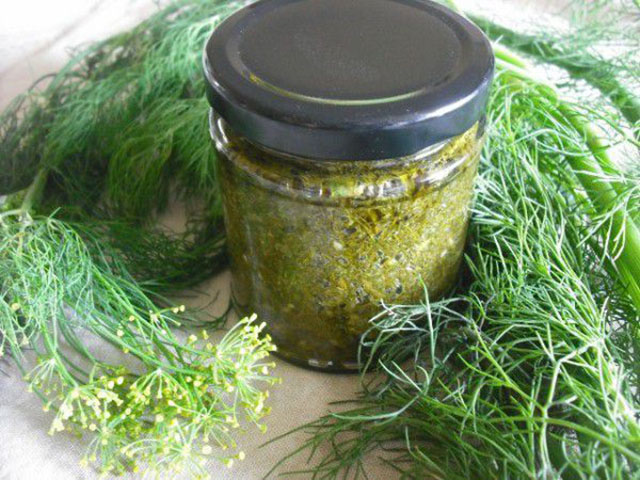
Storage in oil
For those who like to pamper themselves with fresh salad in winter, there is a recipe for preparing dill oil. It is also used for frying, during the preparation of first courses. Sometimes - as one of the ingredients for the sauce. The recipe is very simple.
You will need:
- A small jar, preferably glass.
- The required amount of fragrant spice.
- Oil (you can use both sunflower and olive oil).

Chopped fresh dill is placed in jars, and oil is poured, without the use of salt. The workpiece is placed in a refrigerator and after 1.5-2 weeks the product is ready for use.
Dill with salt for the winter
The most useful of the proposed options for harvesting a fragrant plant is when the grass is simply mixed with salt. A particularly important point in this recipe is not to be mistaken with the proportions of salt relative to herbs.
You will need to prepare:
- Dill - from 1 to 2 kilograms.
- Salt - 350-600 grams.

Cooking process:
- First you need to sort out the stems of the plant. Twigs that are too thick will spoil the taste of the seasoning, so it is recommended to remove them. Prepared leaves and stems are washed well in water several times to remove all kinds of contamination.
- Next, the greens are chopped with a knife. This is done in any form, as it is convenient for anyone.
- As for the necessary container for the blank, here, it is best to prepare glass jars with lids that can be screwed tightly.
- It is recommended to pour salt into the prepared container as the first layer. In order not to overdo it, salt is poured into jars about half a centimeter thick.
- The next layer is dill, the thickness also does not exceed 1 centimeter. Then again a layer of salt, and so on - until the jar is full. But the last layer must be salt.
- When the ingredients are filled in and the container is full, the jar is covered with a lid. The container needs to be shaken well so that the salt crystals mix with the layers of greenery.
- After the can is hermetically twisted and sent to a cold place. To do this, you can use either a refrigerator or a cellar.

How to find the best way to store all vitamins in greens
Every woman, before preparing greens for the winter cold period, first of all, takes care of the safety of the beneficial properties and components of the plant. Which of the following is the best way to choose? So:
- When frozen, almost 90% of all nutrients and vitamins are preserved. In addition, this is also one of the easiest recipes for preparing a fragrant seasoning.
- When greens are stored in a jar of salt, approximately 70% of the vitamin remains.
- Those who choose the drying method, in the winter, when using the seasoning, will receive only 50% of its useful components.
- Marinade recipes kill almost all of the plant's nutrients and are considered impractical.However, pickled greens are delicious and are often used as an addition to main meals or snacks.
It does not matter how this useful herb will be stored, the main thing is to have time to prepare the seasoning in time. Indeed, in almost every family, it is actively used in the home menu. Using the recipes described above, each housewife will delight herself and her family with aromatic dishes on cold evenings.
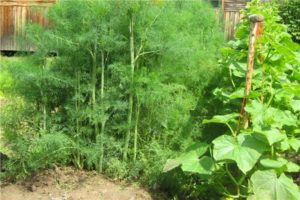
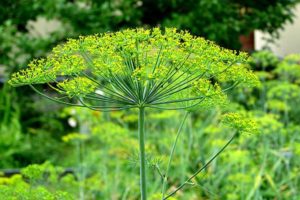








I harvest urop by drying and freezing. I like to freeze more, it is dry and crumbly, the color is bright green. But I liked the recipe for canning with salt, I will definitely try this summer.